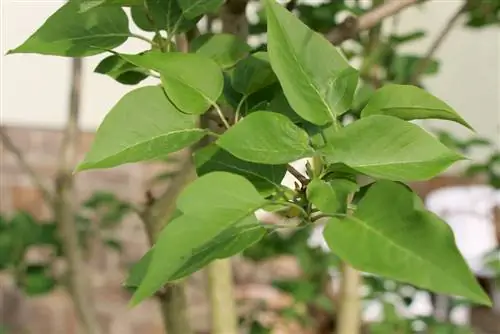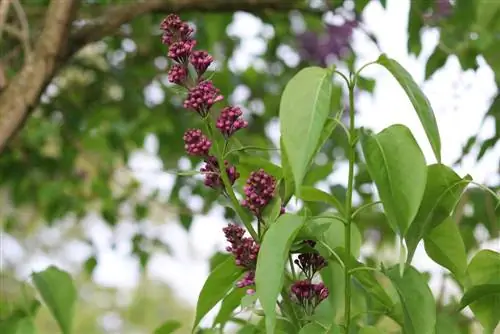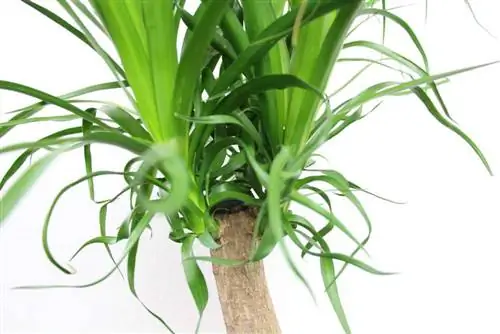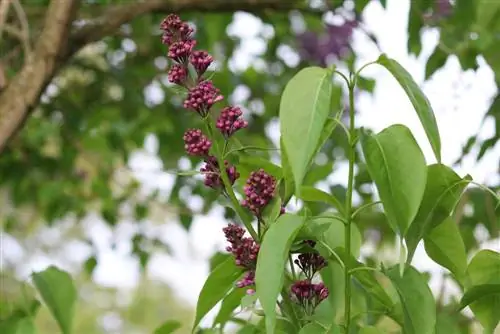- Author admin [email protected].
- Public 2023-12-17 03:39.
- Last modified 2025-01-24 12:45.
Cut lilacs or not? When it comes to fragrant plants, there are clear advantages and disadvantages to this care measure, as the lilac can do well for years without cuttings. But if it is missing for too long, the plant begins to age very quickly, shoots remain bare and the flowering also decreases significantly. However, with the right knowledge, a middle ground can be found or a radical blend can be carried out well. Here we reveal what is important.
Without waste
Lilac is one of the few plants that does very well without cuttings - and does so for many years. In fact, the plants initially grow and bloom particularly luxuriantly if the secateurs are kept away from them.
This circumstance is due to the fact that flowers only form on two-year-old wood and the buds for the next year are already there when the current stands are just withering. With a radical trimming, all flowering plants can be removed for the next two to three years.
But this comfortable state doesn't last forever. Over time, the shoots of the lilac not only become woody, they also age and then neither produce leaves nor flowers. It is therefore not generally advisable to cut the lilac regularly.
Blend inflorescences
The simplest way to trim lilacs is to remove the withered inflorescences. As soon as these have bloomed, you can use scissors. However, caution is advised here, because the buds for next year are waiting right behind them. Green sections should therefore never be cut away unless the flowering is to be restricted. Cutting the inflorescences is possible throughout the entire gardening season.
Tip:
With this type of trimming, it makes sense to also remove bare or weakly leafy branches.
care cut
In principle, the care cut for lilacs is simply an extension of the removal of the dried inflorescences. This involves removing all branches and plant parts that:
- growing “crosswise”
- are dead
- only have a few leaves
- very long and woody but with few leaves
- are bent
Occasionally it is necessary to penetrate deeper into the interior of the lilac for this purpose. This is easier when the lilacs are not in full bloom. On the other hand, it is precisely then that dead and weakly growing branches can be easily identified.
One advantage of caring for the lilac is that it can in principle be done all year round. So it can be done gradually throughout the gardening season and can easily be carried out step by step. Whenever a section becomes disturbing, it is possible to shorten it.
Topiary
Topiary cutting can be necessary for many reasons. If the lilac gets too tall or too wide, it can use this. It may be necessary if the plant is to be grown into a specific shape.

We can proceed relatively radically here. For larger specimens, however, at least one meter above the ground should be maintained. It is also advisable to proceed step by step when pruning. Instead of “cutting down” the lilac in one year and cutting it, the measure should take place over two to three years.
The lilac loses fewer leaves and therefore less strength. For older specimens, it is recommended to proceed from the inside out. This seems unnecessarily complicated at first, but it follows the natural aging and baldness of the plant from the inside out.
Radical cut
Even if the lilac does not need any trimmings for the first few years, at some point it begins to age and thus become bald. The flowering power decreases. The growth of the leaves slows down. Some branches remain completely bare. In addition, there is hardly any space for new shoots.
If a completely overgrown condition has occurred, a radical cut may be necessary. However, you can first try to carry out a topiary step by step over two to three years.
If you don't have patience for this and want to run the risk of it dying completely, you can also shorten all shoots to about one meter above the ground. In the case of very old and weakened plants, however, there is a risk that the plant will no longer recover or will only recover very slowly.
Therefore, it should be carefully considered whether a radical cut is really necessary. If the baldness is bothersome but the lilac is weakening, the plant should be strengthened with appropriate fertilization and not radically pruned until the following year. However, a he althy lilac usually recovers from radical cutting without any problems and then sprouts again very strongly.
Rejuvenation cut
The rejuvenation cut is nothing more than an ongoing maintenance cut combined with the removal of the withered inflorescences. If you cut off all withered, bare and damaged parts of the plant throughout the year, you will never have to carry out a radical cut.
This can seem confusing to some hobby gardeners, because this form of rejuvenation usually produces misshapen-growing plants. In the case of lilacs, however, the measure ensures compact and lush growth.
Safety measures
Even if cutting lilacs is generally quite uncomplicated and the plant tolerates cutting well, there are a few points that need to be taken into account. These primarily include:
- use clean cutting tools to avoid transferring germs or parasites
- Do not cut in extremely hot and dry weather or in sub-zero temperatures
- Strengthen the plant before cutting with appropriate fertilization and correct watering
- Better a little bit every year than really radical once
Whether it's an inflorescence, a bare branch or a radical cutting, these rules apply in any case.
Care before and after the cut
The lilac is generally very easy to cut and grows back. To do this, however, he needs the right source of power. Nitrogen and phosphorus are important nutrients that can serve as a source of strength. Even with the right care, however, it takes a few years for the lilac to become strong again and develop new shoots and leaves. It can take three to four years for new inflorescences to form.
Suitable supply options are compost and organic products such as compost, bone meal, blood meal and hair meal. Ready-made fertilizers for flowering plants from specialist retailers are also available. Incorporated into the upper substrate layer and distributed with water, these can lead to new strength within a few months.
It is also important that the lilac is not weakened by other influences. If there is drought or waterlogging, disease or pest infestation, no large cuttings should be made. The first thing to do here is to fix the problems and let the plant regain its strength.
Only the parts that are already dead or infected should be cut.

It is important to maintain different distances. Dryness, for example, can be remedied very quickly by simply reaching for the watering can every now and then. As soon as the leaves are no longer wilting and limp, they can be cut. The situation is different when there is a nutrient deficiency. Here, regular fertilization should first be carried out for one garden season until the pruning shears are used.
This also applies to a parasite infestation or infection. Only when the plant has recovered should it be cut more radically.
Conclusion
Even if the lilac is actually grateful, easy to care for and robust, the cutting must be done carefully. It is particularly easy if the lilac is continually thinned out and dead branches are removed. So if you keep using secateurs throughout the year, you usually don't have to worry about radical trimmings and will keep the lilac young, sprouting and blooming all year round.






